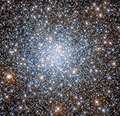Fichier:NGC6638 - HST - Potw2231a.jpg

Taille de cet aperçu : 622 × 599 pixels. Autres résolutions : 249 × 240 pixels | 498 × 480 pixels | 797 × 768 pixels | 1 063 × 1 024 pixels | 2 125 × 2 048 pixels | 2 611 × 2 516 pixels.
Fichier d’origine (2 611 × 2 516 pixels, taille du fichier : 3,35 Mio, type MIME : image/jpeg)
Historique du fichier
Cliquer sur une date et heure pour voir le fichier tel qu'il était à ce moment-là.
| Date et heure | Vignette | Dimensions | Utilisateur | Commentaire | |
|---|---|---|---|---|---|
| actuel | 1 août 2022 à 21:53 |  | 2 611 × 2 516 (3,35 Mio) | Fabian RRRR | == {{int:filedesc}} == {{Information |description={{en|1='''Star-Studded Skyfield This star-studded image from the NASA/ESA Hubble Space Telescope shows the heart of the globular cluster NGC 6638 in the constellation Sagittarius. The star-strewn observation highlights the density of stars at the heart of globular clusters, which are stable, tightly bound clusters of tens of thousands to millions of stars. To capture the data in this image, Hubble used two of its cutting-edge astronomical in... |
Utilisation du fichier
La page suivante utilise ce fichier :
Usage global du fichier
Les autres wikis suivants utilisent ce fichier :
- Utilisation sur ar.wikipedia.org
- Utilisation sur ce.wikipedia.org
- Utilisation sur de.wikipedia.org
- Utilisation sur diq.wikipedia.org
- Utilisation sur en.wikipedia.org
- Utilisation sur eo.wikipedia.org
- Utilisation sur es.wikipedia.org
- Utilisation sur eu.wikipedia.org
- Utilisation sur nl.wikipedia.org
- Utilisation sur tt.wikipedia.org
- Utilisation sur www.wikidata.org

